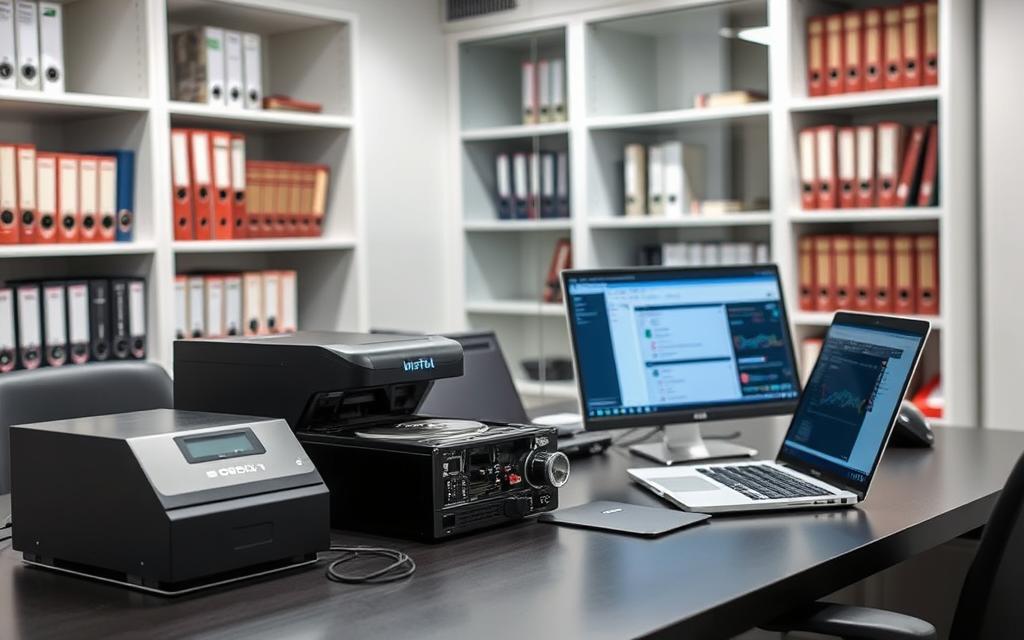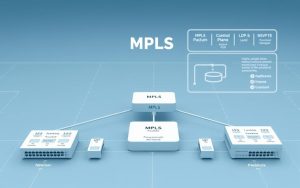In today’s world, digital crime investigation is key to justice. Police use forensic technology solutions to find clues in digital devices. This change shows how crime has moved online in the 21st century.
The US Department of Justice says digital forensics is about systematic analysis of digital data for legal use. It includes data recovery and network tracing. These help solve crimes by tracing back events and finding culprits.
Tools for modern crime detection help in many ways. They fight financial fraud and cyberattacks. These tools are precise and follow the law. As crimes get more complex, so does the need for better tech and experts.
This part looks at how digital forensics has changed how crimes are solved. We’ll see how forensic systems work and how they protect our communities.
The Role of Digital Forensics in Modern Crime Solving
Crime-solving today focuses on digital clues, moving away from physical evidence. This change is due to technology advancements and criminals’ use of digital tools. Cognyte found that 90% of today’s crimes involve digital evidence.
From Fingerprint Dust to Data Recovery
Historical Context of Crime-Solving Techniques
Until the late 20th century, traditional forensic methods were key:
- Latent fingerprint analysis (1880s)
- Blood type categorisation (1901)
- Ballistic fingerprint matching (1925)
The 1980s saw a shift with the Association of Police Units starting digital forensic units for computer crimes.
The Paradigm Shift Towards Digital Evidence
Several factors drove this change:
| Factor | Impact | Example |
|---|---|---|
| Smartphone adoption | 93% of adults carry potential evidence sources | Location data recovery |
| Cloud storage | 67% corporate data now off-premises | Email server analysis |
| Payment digitisation | New fraud patterns emerging | Central Florida check fraud adaptations |
Defining Digital Forensics
Official Definitions from US Department of Justice
“The scientific examination and analysis of digital media to recover actionable intelligence while maintaining legally admissible chain-of-custody protocols.”
Key Differences From Traditional Forensics
Digital investigations need unique methods:
- Evidence exists in multiple jurisdictions at once
- Data needs special tools for recovery, not physical collection
- Analysis is at the bit level, not molecular
This shift requires ongoing training. Since 2018, forensic data analysis certifications are essential for federal investigators.
How Technology Is Used to Solve Crimes
Today, solving crimes relies on advanced tech. It extracts digital clues from devices, networks, and the cloud. These methods help investigators piece together timelines, find suspects, and secure convictions with great accuracy.

Device Analysis Fundamentals
Forensic experts use special tools to get data from phones and computers. Cellebrite UFED, for instance, gets past encryption on modern phones to find deleted messages or where someone was. This includes:
- Physical extraction: Directly accessing device storage
- Logical extraction: Copying organised file structures
- File system bypass: Exploiting manufacturer protocols
Smartphone Extraction Techniques
For damaged devices, investigators use chip-off forensics. They remove memory chips. Tools like EnCase Forensic make exact copies of storage media, keeping metadata for court use.
Computer Hard Drive Imaging Processes
FTK Imager makes forensic images while keeping logs. This stops data tampering. It lets many analysts look at the same evidence without changing it.
Network Forensics in Action
Criminal communications leave digital clues on servers and routers. Network traffic analysis spots patterns in data packets. This reveals hidden links between suspects.
| Tool | Function | Case Use |
|---|---|---|
| Wireshark | Real-time packet inspection | Identifying unauthorised logins |
| NetworkMiner | File extraction | Recovering transmitted images |
| Zeek | Protocol analysis | Detecting data exfiltration |
Tracking Digital Communications Patterns
Metadata from emails and messaging apps shows who talked to whom, when, and from where. Investigators match this with mobile tower records to check alibis.
IP Address Tracing Methodologies
Tools track suspects through VPNs and proxy servers. Law enforcement works with ISPs to link IP addresses to locations at specific times.
Cloud Evidence Acquisition
With 55% of organisations using cloud storage (Cognyte 2023), cloud forensics tools face legal hurdles. The GDPR-CLOUD Act conflict often delays getting data from foreign servers.
Legal Challenges in Multi-Jurisdictional Data
A 2022 AWS investigation needed warrants from three countries. Investigators used Mutual Legal Assistance Treaties to access servers in Frankfurt, Sydney, and Virginia at once.
Tools for AWS and Azure Investigations
APU’s Cloud Forensics Toolkit automates collecting evidence from major platforms. It keeps track of access times and user roles. This is key to proving data theft was intentional, not accidental.
The Digital Forensics Process: Step-by-Step
Today’s digital investigations use strict scientific methods to make sure evidence is strong in court. This careful approach mixes technical skill with legal rules, turning raw data into useful information. Let’s look at the four main steps in this process.
1. Evidence Identification Phase
First, investigators figure out which devices have important data. They focus on systems with data volatility prioritisation. This means they quickly check memory cards and live systems because their data can vanish when power is lost.
Chain of Custody Protocols
APU’s way of handling evidence includes detailed records of every move. They use tamper-proof seals and digital logs. This makes sure there’s a clear evidence chain of custody that courts need to accept the evidence.
Data Volatility Prioritisation
- RAM captures before shutdown
- Cloud session data preservation
- SSD trim command suspension
2. Preservation and Collection
Experts use tools like the Tableau T8 write-blocker to stop data from being changed by accident. Cognyte’s tools help automate this step while keeping forensic imaging standards.
Write-Blocker Implementation
These tools make a one-way path for data, allowing reading but not writing. Some popular ones are:
- Tableau TX1 for mobile devices
- WiebeTech Forensic ComboDock
Forensic Image Creation Standards
They make exact copies of data using:
- SHA-256 hashing for verification
- AFF4 format for compression
- Multiple storage checks for redundancy
3. Analysis Techniques
This step turns raw data into evidence ready for court. Metadata analysis is especially useful for showing timelines and user actions.
Keyword Searching With Regular Expressions
Advanced pattern matching finds hidden data:
“\b\d{3}-\d{2}-\d{4}\b” matches US social security numbers
Timeline Reconstruction Using Metadata
They use file system timestamps and browser histories to:
- Show when users were present
- Confirm when documents were accessed
- Track data theft attempts
4. Documentation and Reporting
Every finding is explained in simple reports that meet Daubert standards. Investigators often explain technical details to juries during expert witness testimony.
Court-Admissible Evidence Preparation
Final reports include:
- Original media hashes
- Tool validation certificates
- Descriptions of analysis methods
Expert Witness Testimony Requirements
Federal Rules of Evidence Article VII requires:
- Certification from recognised bodies
- Peer-reviewed methods
- Disclosures of error rates
Essential Tools for Digital Investigations
Today’s investigators use special software to understand digital clues. EnCase, Cellebrite, and Autopsy are top choices. Each meets different needs while keeping forensic standards high.

EnCase Forensic Solutions
EnCase is a favourite among 73% of US federal agencies (Cognyte DFaaS data). It’s great for detailed device analysis. It can crack over 30 file systems, like BitLocker and VeraCrypt.
Mobile device support overview
The software can pull data from:
- iOS backups (including deleted Health app records)
- Android physical acquisitions
- Satellite phone metadata
Cellebrite UFED Series
Cellebrite is a top pick for mobile data, covering 95% of smartphones since 2015. It’s known for its advanced extraction features. It can find:
- Encrypted WhatsApp business chats
- Geofence-aligned location histories
- Factory-reset protected files
Cloud analytics integration
The UFED Cloud Analyzer works with:
- iCloud backup snapshots
- Google Takeout archives
- Microsoft 365 audit logs
Autopsy Open-Source Platform
Autopsy is used by 68% of digital forensics programmes (APU case studies). It’s a cost-effective option for investigations. It offers:
- Plugin-driven case management
- Cross-platform timeline analysis
- Tor network artifact detection
Community support ecosystem
Users get help from:
- Public GitHub issue tracking
- Crowdsourced regex pattern libraries
- University-developed training modules
Notable Case Studies and Outcomes
Digital forensics has made huge impacts in solving big cases around the world. These examples show how cryptocurrency forensics and corporate data protection have changed crime-solving.
Silk Road Dark Web Takedown
The FBI’s takedown of Silk Road in 2013 was a big win in dark web investigations. They used blockchain analysis and old-school detective work to catch Ross Ulbricht, the site’s owner.
Bitcoin Transaction Tracing Methods
Agents used special algorithms to connect Bitcoin addresses to people’s identities. They looked at how transactions moved through exchanges to find Ulbricht’s wallet, even with his attempts to hide it.
Server Location Identification Techniques
To find hidden servers in Iceland, they:
- Examined PHP error logs for IP addresses
- Made secret purchases with fake names
- Worked with European cyber teams
Corporate Espionage Prevention
In 2021, a study by APU showed how corporate data protection teams stopped a £2.3 million scam. They found hidden data in emails using special tools.
Email Metadata Analysis Successes
They found:
- Altered timestamps in emails
- IP address mismatches
- Unusual forwarding rules
Data Exfiltration Pattern Recognition
Cognyte’s systems spotted odd network actions by:
| Pattern | Frequency | Data Type |
|---|---|---|
| Late-night SQL queries | 3× normal rate | Customer databases |
| ZIP file uploads | 92% increase | Design schematics |
These stories show how digital forensics links tech skills with legal action. From cryptocurrency forensics to stopping insider threats, investigators keep finding new ways to outsmart cybercriminals.
Navigating Tomorrow’s Digital Crime Scene
The future of digital forensics is set to face big challenges as technology advances. By 2030, there will be 29 billion IoT devices. This means investigators will need to find evidence in smart homes, wearables, and cars.
Quantum computing brings new risks to how we encrypt data. But it also could help us break through encryption to find hidden information.
Cognyte’s research shows AI and machine learning will change how we solve crimes. These tools can quickly find patterns and spot connections in big data. This helps tackle the complex world of cloud crimes and cyberattacks across borders.
APU’s cybersecurity courses keep up with these changes. They now teach about IoT forensic analysis and quantum-safe cryptography. This training helps professionals deal with new threats like deepfake fraud and money laundering on blockchain.
Staying ahead in crime-solving requires constant learning. Investigators need to know about tools like Cellebrite’s Quantum and the laws for sharing data across borders. Regular technical training helps keep organisations safe from advanced threats.
For those looking to work in this field, getting the right training is key. Courses that mix digital forensics with data science prepare experts for the future. See how APU’s degrees align with industry needs and prepare leaders in this fast-changing field.







